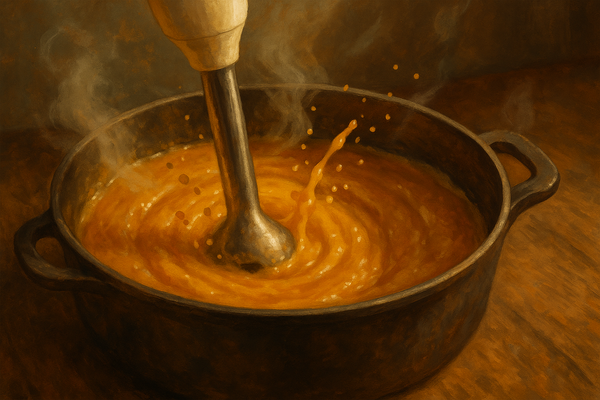
The Hum Behind the Spoon
Every cook has a sound that means progress.
For some it’s the hiss of onions. For others, the crack of crust.
For me, it’s the quiet hum of an immersion blender finding its rhythm — that vibration through the wrist when liquid becomes something more than liquid.
The immersion blender doesn’t just mix. It reorganizes.
It takes the chaotic ingredients of a pot — soup, sauce, purée — and gives them a single voice.
Power at the wrist, control at the fingertips.
It’s a small miracle of mechanics: a blade fast enough to shear, yet gentle enough to preserve character.
The Physics of Smoothness
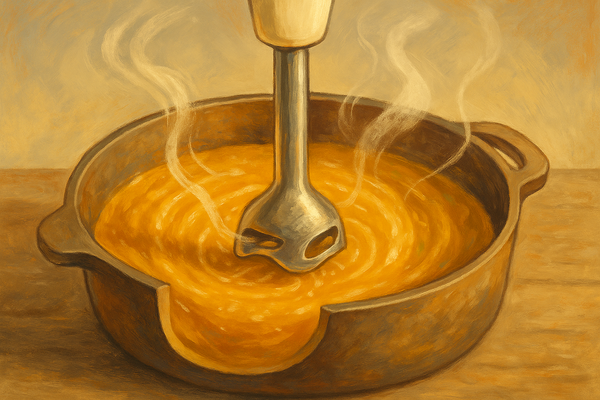
What happens in that pot is called shear force.
When a blade spins at thousands of revolutions per minute, it creates turbulence that tears apart structure — starch, fiber, protein — until the pieces are too small to separate.
That’s the difference between chunky soup and velvet.
The movement is paradoxical: destruction as creation.
You’re breaking bonds so new ones can form. In that turbulence, water and fat stop fighting. Air sneaks in. The liquid thickens, emulsifies, stabilizes.
It’s the same science behind mayonnaise or hollandaise, just sped up and held steady by a motor instead of a whisk.
The immersion blender democratized this kind of precision.
No copper bowl, no whisking arm, no technique barrier. Just a wand, a hum, and a little nerve.
Observation: Smoothness isn’t about perfection. It’s about alignment.
Emulsion: The Marriage of Opposites
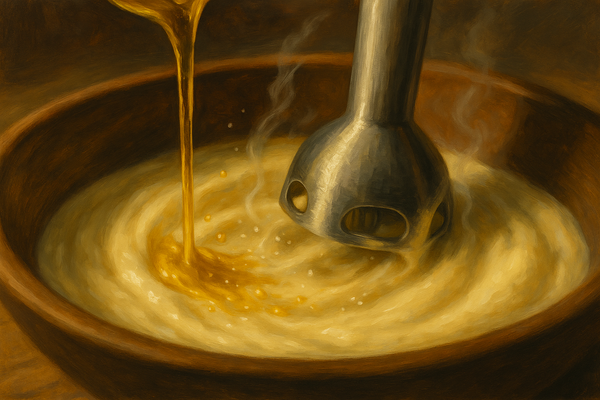
Every emulsion is a truce. Oil and water want nothing to do with each other, but with enough motion, they give in.
That’s what emulsification is: physics bending toward flavor.
The immersion blender makes that visible. You can literally watch the molecules negotiate — clear oil turning opaque as it disperses into microscopic droplets.
It’s chemistry disguised as therapy.
And it changes the way you cook.
Instead of emulsions being special — reserved for restaurants or textbooks — they become casual. Wednesday-night food. The line between home and professional blurs because the tool lets you feel the transition.
Truth from experience: The secret to control isn’t force. It’s proximity.
The Pleasure of Precision
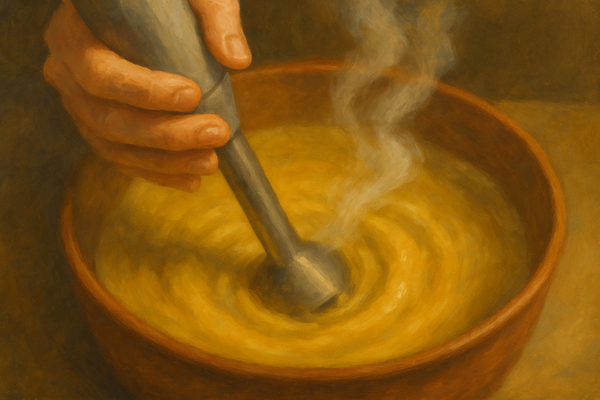
Using an immersion blender is one of the most tactile acts in cooking.
You hold the motor in one hand, the pot in the other, and find balance between them.
Too shallow and it splashes. Too deep and it drags.
You start to hear texture before you see it — a thicker pitch, a smoother tone.
That’s how you know you’re done.
It’s sound, not sight, that tells you the soup has crossed from rough to silk.
The pleasure comes from that control — the intimacy of transformation happening right under your palm.
Most kitchen tools create distance. This one brings you closer.
From Home to Haute Cuisine
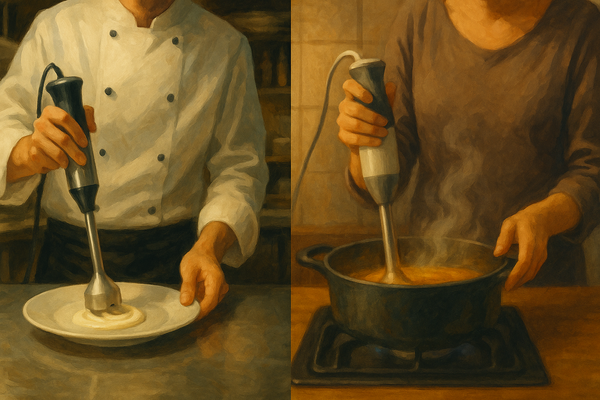
Before immersion blenders, emulsions lived mostly in restaurants.
They required steady hands and years of repetition. Then the wand arrived — small, affordable, unpretentious — and suddenly anyone could make a sauce that held together.
That’s the quiet revolution: it didn’t just make cooking easier; it made texture democratic.
The same motor that powers a soup also builds a hollandaise, aerates cream, or emulsifies a vinaigrette.
It’s not flashy. It’s engineering turned empathy.
Because control in the kitchen isn’t about power. It’s about connection — between hand, heat, and hunger.
The Science of Shear

Shear force breaks big things into little ones.
In food terms, that means smoother textures, thicker body, and more surface area for flavor to cling to.
A bisque feels rich not because of cream, but because every molecule of lobster shell and butterfat is suspended in the same cloud.
High shear also introduces air — turning sauces lighter, soups brighter, purees more elegant.
It’s the science of friction turned into pleasure.
The reason velouté feels silkier than it should is that your blender taught the ingredients to get along.
The quiet truth: Smoothness isn’t nature’s default. It’s an act of will.
Cleaning Up
The immersion blender’s only demand is humility.
Unplug it, rinse it, respect the blade. That’s the trade-off for all that power in your hand.
There’s something almost meditative about watching the last swirl of soup rinse away.
Like the machine knows it’s done its job — dissolved chaos into harmony, then stepped back.
It’s not about gadgets. It’s about what happens when you give precision to instinct.
Conclusion: Control, Felt Not Seen

The immersion blender is proof that technology can feel human.
It hums instead of shouts. It teaches touch instead of replacing it.
You don’t have to understand shear force or emulsification to feel it in your hand — the small resistance as liquid thickens, the quiet shift from chaos to calm.
It’s science at skin level.
And in that moment, when the pot goes still and the soup catches the light, you know what every good cook learns eventually:
control isn’t about domination.
It’s about harmony — and the patience to listen for the hum.
